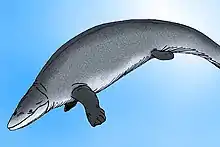Ocucajea
Ocucajea is an extinct genus of basilosaurid cetacean from Middle Eocene (Bartonian stage) deposits of southern Peru. Ocucajea is known from the holotype MUSM 1442, a partial skeleton. It was collected in the Archaeocete Valley site, from the Paracas Formation of the Pisco Basin about 40.4 to 37.2 million years ago.[1]
| Ocucajea Temporal range: Middle Eocene (Divisaderan), | |
|---|---|
 | |
| Scientific classification | |
| Domain: | Eukaryota |
| Kingdom: | Animalia |
| Phylum: | Chordata |
| Class: | Mammalia |
| Order: | Artiodactyla |
| Infraorder: | Cetacea |
| Family: | †Basilosauridae |
| Genus: | †Ocucajea Uhen et al. 2011 |
| Species: | †O. picklingi |
| Binomial name | |
| †Ocucajea picklingi | |
The genus was named after the town Ocucaje in the Ica Province near the type locality, and the species after José Luis Pickling Zolezzi, naturalist, artist, and an important contributor to Peruvian palaeontology.[2]
Ocucajea is smaller than all other dorudontines. It differs from Saghacetus and Dorudon in cranial morphology; in Ocucajea the nasals extends farther posteriorly than the maxillae, and there is no narial process of the frontal like in Saghacetus.[3]
References
- Ocucajea at Fossilworks.org
- Uhen et al. 2011, Etymology, p. 963
- Uhen et al. 2011, Diagnosis, p. 963
Bibliography
- Uhen, Mark D.; Pyenson, Nicholas D.; Devries, Thomas J.; Urbina, Mario; Renne, Paul R. (2011). "New Middle Eocene Whales from the Pisco Basin of Peru". Journal of Paleontology. 85 (5): 955–969. doi:10.1666/10-162.1. hdl:10088/17509. OCLC 802202947. S2CID 115130412.
